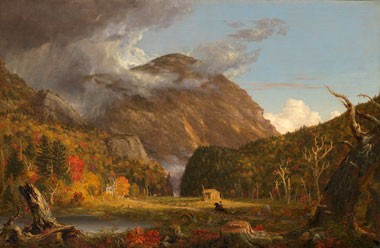Grade Level: 7–8
Students will explore nineteenth-century life in the White Mountains of New Hampshire through a tale of a family who lived there by analyzing a painting by Thomas Cole and reading a short story by Nathaniel Hawthorne. They will then write a comparative essay and complete a mathematics worksheet to enhance their perception of American life in the nineteenth century.

Thomas Cole
American, 1801–1848
A View of the Mountain Pass Called the Notch of the White Mountains (Crawford Notch), 1839
oil on canvas, 102 x 155.8 cm (40 3/16 x 61 5/16 in.)
National Gallery of Art, Andrew W. Mellon Fund
Curriculum Connections
Materials
Warm-Up Question
Something bad is about to happen in Crawford Notch. What part of the natural setting tells us this?
Background
In the first half of the nineteenth century, many settlers moved from farms and towns on the eastern seaboard to seek their livelihoods in the mountains and on the western frontier. One such family was the Samuel Willeys who settled in Crawford Notch in the White Mountains of New Hampshire. Their reason for choosing this location may have been that the notch, one of three deep valleys in the area, was an important route through the mountains and had a turnpike by 1804. The Willeys met a terrible fate in an avalanche. The tragic events were recorded in numerous short stories, poems, and paintings. The tale became a popular one for the American people because the young nation had a short history and few stories of its own.
The avalanche occurred on August 29, 1826. An unusually hot and dry summer made the slopes of the notch susceptible to slides. A sudden downpour broke loose a stream of rock and debris that descended two thousand feet toward the Willey house. The family, hearing the noise, fled their home looking for a safer haven. Unfortunately, they ran directly into the avalanche that, ironically, missed the house completely.
Thomas Cole, America’s leading landscape painter during the first half of the nineteenth century, had been to the notch several times. He emigrated from England with his family in 1801 and eventually settled in Catskill, New York, a small village on the west side of the Hudson River and close to the Catskill Mountains. Scenery from across the northeast provided inspiration for many of his paintings. In 1828 he traveled to Crawford Notch and wrote in his diary:
We now entered the Notch, and felt awestruck as we passed between the bare and rifted mountains. . . . The site of the Willie [sic] House standing with a little patch of green in the midst [of] the dread wilderness of desolation called to mind the horrors of that night. . . when these mountains were deluged and rocks and trees were hurled from their high places down the steep channelled sides of the mountains. . . .
Cole did not show the actual disaster or the Willey House. Instead, he painted the scene as he found it. Cole did include the bare areas on Mount Webster where the landslide started, as well as the well-known Notch House, an inn built on the site two years after the tragedy. Rather than concentrating on the human drama, the artist painted a vast landscape to underscore humankind’s insignificance and vulnerability in the face of nature. Only the storm clouds looming over the mountain hint of something sinister.
Guided Practice
Activity
The avalanche inspired a number of writers, including Nathaniel Hawthorne (1804–1864), who was born and raised in Salem, Massachusetts. The success of Twice-Told Tales, a collection of stories, including “The Ambitious Guest” about the tragedy at Crawford Notch, established his reputation as a writer. Hawthorne took the well-known facts of the Willey disaster and added a character, who had not been part of the actual event: the “ambitious guest,” a young traveler on his way to seek fame and fortune, who stops for the night at the Willey home. The irony in Hawthorne’s story was that the guest did not live to see his ambitions realized, for he perished with the family.
Students will now read this short story “The Ambitious Guest” by Nathaniel Hawthorne from Twice-Told Tales (1837) and write a comparison essay to the painting by Thomas Cole. In their essay, they should consider the following questions:
Extension
Students will complete the “Mathematics Problems about the 1800s” worksheet that uses issues about life in the nineteenth century as the basis for mathematics word problems.
VA:Cn11.1.7 Analyze how response to art is influenced by understanding the time and place in which it was created, the available resources, and cultural uses.
VA:Re7.2.7 Analyze multiple ways that images influence specific audiences.
VA:Re8.1.8 Interpret art by analyzing how the interaction of subject matter, characteristics of form and structure, use of media, art-making approaches, and relevant contextual information contributes to understanding messages or ideas and mood conveyed.
Borrow the teaching packet Art&
Borrow the DVD American Art, 1785-1926: Seven Artist Profiles
Download or borrow the teaching packet The Inquiring Eye: American Painting
Add primary sources from the Library of Congress’s “American Memory” project